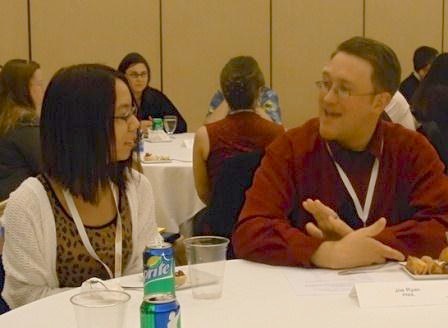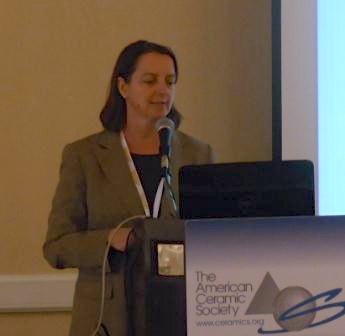Joe Ryan (right) talks about his career at the Pacific Northwest National Lab during Monday’s career roundtable event for students at PACRIM. Credit: Fei; ACerS.
(Editor’s note: We ran into some website compatibility issues, which delayed this post by a day. We hope to catch up with Ling’s perceptive observations of the conference today and tomorrow.)
Today (Monday) is the first full day of PACRIM 10. The meeting was kicked off with the welcome address from H.T. Lin, the chairman of the conference. He briefly reviewed the history of PACRIM and introduced the technical programs held in this meeting. It is exciting to know that this meeting attracted more than 900 people from 39 countries all over the world. No wonder I was able to meet so many people in the reception!
Jeffrey Wadsworth, CEO of Battelle Memorial Institute, gave the first plenary talk. He pointed out the main challenges faced by the world including the sharp increase of world population, the conflict between depletion of fossil fuel and increasing energy demand, and biohealth problems (e.g. infectious disease, global aging). By offering ceramics as a solution to those challenges, he stressed the importance of the ceramic materials. One fact I appreciate, too, is that Battelle Memorial Institute also puts great effort in STEM education, aiming to inspire young people.
The second talk, given by Tomoyoshi Motohiro from Toyota Central R&D, was also energy-related. One of his research programs, focused on preparing photocatalysts for converting CO2 into organic compounds, could be an exciting remedy to the greenhouse effect once scaled up. The other two plenary speakers, M.K. Badrinarayan, vice president and research director of Corning Incorporated and Hong-Kyu Park from LG Chem Battery R&D also focused on the energy crisis, storage, and conversion problems. Together, the four talks set energy as one of the most important topics in this meeting. As a student working in the energy area, I am pleased to realize how meaningful my research is.
Monday afternoon, a lot of research talks were delivered in different rooms. I attended the invited lecture “Spark Plasma Sintering and Mechanical Behavior of Pure Tungsten with Improved Microstructures.” Julie Schoenung, professor at University of California, Davis, impressed the audience with the great improvement achieved in mechanical behavior of tungsten powder. Usually, spark plasma sintering is done under less than 100 MPa of pressure, but they can apply pressures up to 1,000 MPa. The high pressure can greatly accelerate the densification behavior, helping to achieve high relative density. During the break, several audience members surrounded Schoenung for further discussion or questions. Though there has been great progress, one researcher commented that the retention of nano grain size was not successful because of significant grain growth under high temperature.
At the end of the day, the ‘Student Career Roundtable’ was a big success. This event connected young students with experienced researchers from industry, national labs, and universities. Specifically, students had the chance to ask any questions, especially about career choice, from invited career professionals. For example, at my table, Joe Ryan from Pacific Northwest National Laboratory explained the difference between conducting a research career in national lab and university. As he concluded, university professors especially assistant professors, have to do lots of activities such as teaching class, writing proposals, and guiding graduate research, which could be stressful and hard to balance family and career. Ryan says that at a national lab, one can focus solely on research. As well, there are great chances to work on different projects and lots of cross-group collaboration. Therefore, he likes working in national lab. In contrast, Erica Corral, a young female professor from University of Arizona who did a postdoc at Sandia National Lab, really enjoys her career as a professor. She enjoys the research freedom of a university career rather than having to be part of big projects determined by the national lab. Also one of the plenary speakers, M.K.Badrinarayan offered insights on what kind of traits make a good researchers in industry and the type of talents sought by industry research groups. Such an event definitely helps young students, including myself, choose their career path.
I had a wonderful day—a great beginning!


